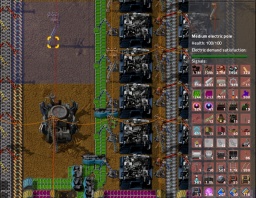Circuit network: Difference between revisions
No edit summary |
|||
| Line 77: | Line 77: | ||
== See also == | == See also == | ||
* [[Circuit network (research)]] | |||
* [[Transport network]] | * [[Transport network]] | ||
* [[Combinators]] | * [[Combinators]] | ||
Revision as of 18:05, 13 April 2016
Circuit networks (CCNet) enables the control of devices based on the amount of Items and Fluids stored in all Chests and Storage tanks connected to the same network via red or green wires.
A more technical explanation is, that the circuit network is a standardized bus-system. See this explanation.
Even if the circuit network looks quite different to the Logistic network, the bus is principally the same beccause the information is the same. The basic difference between them is that, in a logistic network, everything which is covered by a roboport pops up as content, but in the circuit network only the connected chests and storage tanks were considered.
Items/Devices
| Red wire | Wires used to connect smart devices to a red network. |
| Green wire | Wires used to connect smart devices to a green network. |
| Smart chest | The most basic chest connectable to Circuit networks. Its content will be sent to the network. |
| Active Provider chest | A chest connectable to Circuit networks and participating in the Logistic network. Its content will be sent to the network. |
| Passive Provider chest | A chest connectable to Circuit networks and participating in the Logistic network. Its content will be sent to the network. |
| Requester chest | A chest connectable to Circuit networks and participating in the Logistic network. Its content will be sent to the network. |
| Storage chest | A chest connectable to Circuit networks and participating in the Logistic network. Its content will be sent to the network. |
| Storage tank | The storage tank is also connectable to Circuit networks (since v0.12). Its fluid content will be sent to the network. |
| Smart inserter | The only inserter connectable to Circuit networks and Logistic networks. The condition when the inserter is working is configurable in the menu. |
| Lamp | The lamp is connectable to Circuit networks. The condition when the lamp is shining is configurable in the menu. |
| Small pump | The small pump is connectable to Circuit networks. The condition when the pump is working is configurable in the menu. |
| Offshore Pump | The offshore pump is connectable to Circuit networks. The condition when the pump is working is configurable in the menu. |
| Constant Combinator | The constant combinator is connectable to Circuit networks. You can set up to 15 signals in its GUI which will be sent to the network (like a chest that contains pseudo items). It has several outputs for red and green wires. |
| Arithmetic Combinator | The arithmetic combinator is connectable to Circuit networks. It can perform mathematical operations (+, -, *, /) based on the amounts of the inputs signals (red and green wire signals are summed). |
| Decider Combinator | The decider combinator is connectable to Circuit networks. It acts like any signal controlled device. You can compare the input signals (red and green wire signals are summed) by using "less than", "bigger than" or "equal to". If the condition is true, it will output a configurable signal. |
Basic
The circuit network is often use to control the amount of certain items or fluids in the factory. Before the storage tank, lamp, small and offshore pump were included to the circuit network, the basic usage was to connect a smart inserter with a chest next to it to control the amount of items in the chest.
Advanced
The smart bus page explains the function of the bus.
There are several links into the forum (outdated):
- Forum article about the basic usage
- About comparison of the circuit wires with examples from the real world
Receivers
Smart inserters, Lamps, Small pumps and Offshore pumps are currently the only devices connectable to the circuit network. If a circuit condition is set, they only work if this condition is true. When it is connected to the network, it is possible to set up the condition in three parts:
- Item or fluid. To check the condition, the amount of the given item or fluid in the connected circuit network is taken.
- Type of the condition: less than, bigger than, equal
- Item or fluid. To check the condition, the amount of the given item or fluid in the connected circuit network is taken.
Both values will be compared by using the given type of the condition.
Multiple networks
It is possible to establish multiple distinct networks of the same color. Just make sure that there is no wire connection between them and they will be treated as separate networks.
Examples (outdated)
- Logic Gates, Edge Detector
- Logic gates revisited
- Evenly fill two item onto one lane
- Material splitters
- Logic gates using side inserter mod

